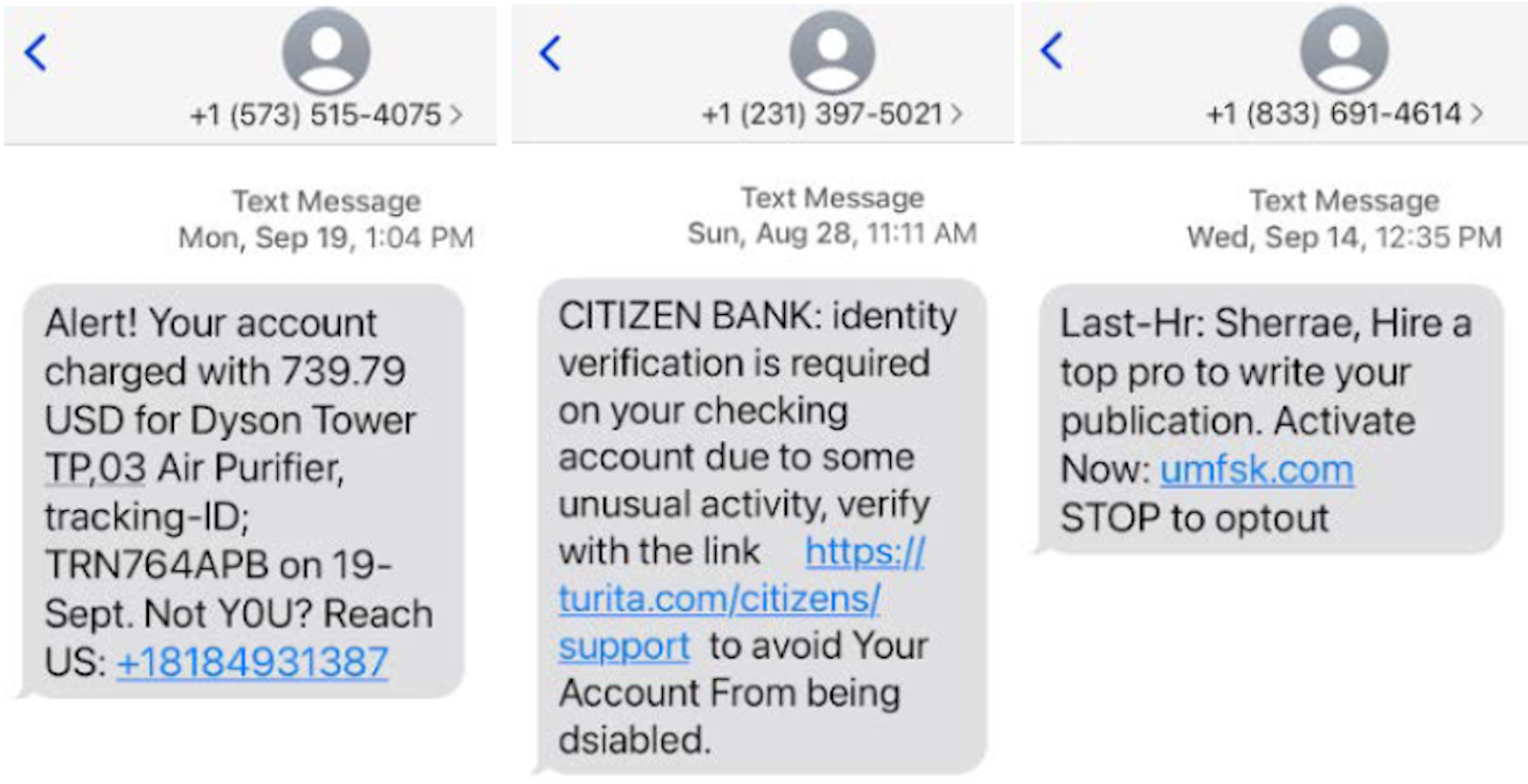
As robotexts skyrocket, new efforts emerge to fight scam texts and robocalls
Robocalls and robotexts didn’t become a serious problem overnight and it’s not going to be solved overnight. These are real developments. Still, much, much more needs to be done by regulators, lawmakers, educators and consumers.

For those of us annoyed or even outraged by unwanted robocalls and robotexts (isn’t that almost everyone), there’s been a lot of news during the last couple of weeks:
- The Federal Communications Commission (FCC) this month notified seven phone companies they will be shut down for allowing scam robocalls on their networks. This marks the first time the FCC has made such a move.
- The FCC has finally proposed new rules to crack down on scam robotexts, a year after it was proposed by the FCC chairwoman.
- Scam robotexts have continued to rise the last few months after skyrocketing since last year, according to companies that track them. As a nation, we received 1 billion spam robotexts a month last year. That’s up to 15.6 billion a month in September 2022.
- Meanwhile, unwanted robocalls continue to decline but remain a troubling issue that costs consumers time and money.
Robocalls and robotexts didn’t become a serious problem overnight and it’s not going to be solved overnight. These are real developments. Still, much, much more needs to be done by regulators, lawmakers, educators and consumers.
Bad guys continue to go after our information and our money. Scams are a chameleon-like problem with no end in sight. Robocalls are slowing while robotexts are skyrocketing. We still see phishing emails; meanwhile targeted messages through social media will become a bigger menace in the years ahead.
Here are some details on the recent developments:
Plans to shut down seven phone companies:
A year ago, the FCC told phone companies they’d get shut down if they didn’t disclose to the FCC what they’re doing to block spoofed robocalls. Deadlines came and went, with some threats and letters. The federal law that took effect in June 20, 2021, requires phone providers to take specific steps to reduce spoofed calls, which involve con artists using technology to generate calls that appear to be from certain companies or government agencies or a concocted phone number.
Last week, the FCC’s Robocall Response Team said they planned to knock seven phones companies out of business. The FCC action would put them on a list of voice service providers that are no longer allowed to transmit calls. This would mark the first time the FCC shut down companies for not blocking scam robocalls.
“This is a new era,” FCC Chairwoman Jessica Rosenworcel said in a statement “If a provider doesn’t meet its obligations under the law, it now faces expulsion from America’s phone networks. Fines alone aren’t enough. Providers that don’t follow our rules and make it easy to scam consumers will now face swift consequences.”
It wasn’t that swift, but better late than never. As of July, more than 3,000 phone companies had not installed industry-standard technology to fight scam calls, according to a PIRG Education Fund analysis of the FCC database. That number represents nearly half of companies that reported their status to the FCC. Here’s hoping this move by the FCC puts fear in those that haven’t yet taken steps to follow the law and protect their customers.
The seven facing the FCC’s wrath are small players: Akabis, Cloud4, Global UC, Horizon Technology Group, Morse Communications, Sharon Telephone Company, and SW Arkansas Telecommunications. But if the FCC follows through, all calls from these companies’ customers would be blocked and no calls originated by the companies would go through.
A new effort to squash robotexts:
The FCC in late September proposed requiring cellphone companies to block texts from invalid, unassigned or used numbers, or numbers that government agencies, companies like banks don’t use to contact people. The FCC also wants comments on other ways to combat scam robotexts and the fraud that occurs, including stepping up consumer education.
The rule would basically require cellphone companies to block scam robotexts the same way all phone companies are required to block spoof robocalls.
This summer, the Robotext Scam Prevention Act was introduced in Congress. It would prohibit the use of automated telephone equipment to send unsolicited text messages. Con artists enjoy periodic success because they generally use computers to send out hundreds or thousands of text messages at one time. Even one or two victims can make it worthwhile.
Even with these efforts, scam robotexts are likely to get worse before they get better. Nearly 98 percent of U.S. adults own a cellphone, and fraudsters take advantage of this.
Robotexts are out of control:
Efforts to attack scam robotexts can’t occur quickly enough. As predicted when the law to mitigate scam robocalls took effect last year, con artists shifted to largely unregulated robotexts.
From June 2021 to June 2022, the volume of scam robotexts soared from 1 billion a month to 12 billion a month. In September, just three months later, the volume jumped to 15.6 billion.
The most popular types of scam texts: You’ve been charged for something (that you really didn’t buy,) your postal or package delivery has been delayed, you owe back taxes and the IRS is coming after you, your bank account has been frozen (at a bank you don’t do business with), and so on.
In some ways, scam texts are more dangerous than scam calls because it can be more difficult to detect whether a short text is legitimate or not. It might seem innocent to click on a link (that may contain a virus) or call a phone number provided to get more information. That’s how the con artists get you.
Robocalls continue to decline slightly:
Anecdotally, some folks say they think unwanted robocalls have increased. That may be true for certain populations. Overall, though, unwanted robocalls have decreased.
The federal law requiring phone companies to adopt technology to attack spoof robocalls took effect in June 30, 2021. That month, scam robocalls hit 2.1 billion nationwide, according to YouMail, an industry leader in robocall tracking. Last month, the number of scam robocalls fell to 880 million – less than half of the volume from the year before.
However, YouMail generally defines scam robocalls as those with spoofed or imposter numbers (i.e. the Internal Revenue Service or Amazon or a major bank). Increasingly, YouMail executives believe that many calls categorized as telemarketing calls are actually robocalls with fraudulent intentions.
Taking that into account, the number of scam robocalls and telemarketing robocalls combined added up to 2.79 billion in June 2021. That dropped to 2.39 billion in June 2022 and 2.11 billion in September 2022. That’s a notable drop.
Bad actors will continue to try and evade detection as long as some small percentage of consumers still fall for scams and as long as some phone companies don’t do more to block illegal calls from traveling on their networks.
Check out our guide with tips to protect yourself from scam robocalls and robotexts.
Topics
Authors
Teresa Murray
Consumer Watchdog, U.S. PIRG Education Fund
Teresa directs the Consumer Watchdog office, which looks out for consumers’ health, safety and financial security. Previously, she worked as a journalist covering consumer issues and personal finance for two decades for Ohio’s largest daily newspaper. She received dozens of state and national journalism awards, including Best Columnist in Ohio, a National Headliner Award for coverage of the 2008-09 financial crisis, and a journalism public service award for exposing improper billing practices by Verizon that affected 15 million customers nationwide. Teresa and her husband live in Greater Cleveland and have two sons. She enjoys biking, house projects and music, and serves on her church missions team and stewardship board.
Find Out More

Apple AirPods are designed to die: Here’s what you should know

New report reveals widespread presence of plastic chemicals in our food

FTC goes after second tax prep firm, H&R BLOCK joins INTUIT TURBOTAX for deceptive claims of “Free tax prep”


